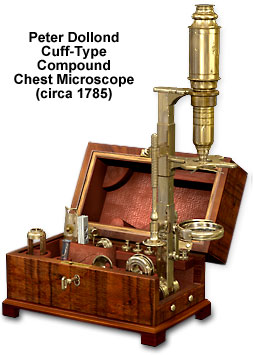Peter Dollond Chest Microscope
The Peter Dollond compound chest microscope is based on improvements to the Cuff-style microscope introduced by British scientific instrument designers Edward Nairne and Thomas Blunt around 1780. The illustration featured below was redrawn from a photograph of the original Dollond microscope that appears in Gerard Turner's book entitled Catalog of Microscopes from the Institute and Museum of the History of Science in Florence, Italy.

Nairne and Blunt's design replaced Cuff's pyramid-shaped microscope case with a more portable, wooden chest that acted as both base and storage box for the optical instrument and its accessories. The Dollond optical instrument firm adopted the popular eighteenth-century design, which employed a hinged brass pillar for rapid assembly and allowed inclination of the microscope for greater comfort and better illumination. Similar to other Cuff-style compound microscopes, a long, brass side screw on the Dollond microscope may be adjusted for fine focusing, while coarse focusing can be achieved by moving the collars holding the stage. The 182-millimeter brass body tube of the instrument fits into a tapered socket at the top of the brass pillar and a cross-shaped stage is equipped with accessory slots and spring clips for glass vials. Beneath the stage, a plano-convex mirror is used to gather light for specimen illumination.
The mahogany chest storage container for the Dollond microscope features a lining of green velvet, stylized wooden feet, and ornate brass hardware. The original accessories of the instrument, which can be stored in the chest, include six numbered achromatic objectives, a light-limiting cone, a Lieberkühn carrier that fits over the nosepiece, a Lieberkühn reflector in a brass case, a spring stage, a fish-plate, stage forceps, a black-and-white disc, and a case of eight ivory sliders. In this illustration, the Dollond microscope case also contains a late-nineteenth-century substage condenser and part of a simple compass microscope that must have been added to the original after its manufacture date, due to their later development.
BACK TO EIGHTEENTH CENTURY MICROSCOPES
